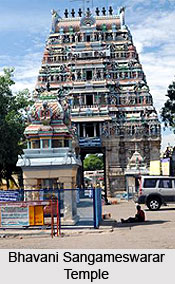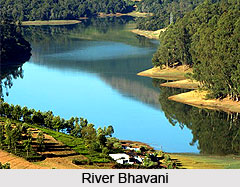 Temples in Erode district are many and are known as Kongunad. The Cholas, Hoysalas and the Pandyas have contributed their mite in the construction of the temples in the district of Erode. There are about four hundred and eighty seven temples in the Erode district. They are located in four taluks, Bhavani, Gobichettipalayam, Erode and Dharapuram. Of the two hundred and seven recognized as padal Petra sthalam, there are two temples found in Erode district called Bhavani and Kodumudi. The Bhavani Sangameswarar temple is situated at the junction of two rivers, the River Bhavani and the River Cauvery. It is called South Prayag and is having a Pagoda of one hundred and twenty inch in height. It is believed that Bhavani and Amudha (not seen now) join Kaveri at this junction, like Jamuna and Saraswati join at Allahabad, Prayag. It is believed to have existed even before the days of the first Kind Mahendravarma of Pallava dynasty. Thirugnanasambandar, one of the four Tamil saints, had sung in praise of this temple. Poet Vasudevan wrote the history of the temple in `Bhavani Kudal Puranam` in Sanskrit.
Temples in Erode district are many and are known as Kongunad. The Cholas, Hoysalas and the Pandyas have contributed their mite in the construction of the temples in the district of Erode. There are about four hundred and eighty seven temples in the Erode district. They are located in four taluks, Bhavani, Gobichettipalayam, Erode and Dharapuram. Of the two hundred and seven recognized as padal Petra sthalam, there are two temples found in Erode district called Bhavani and Kodumudi. The Bhavani Sangameswarar temple is situated at the junction of two rivers, the River Bhavani and the River Cauvery. It is called South Prayag and is having a Pagoda of one hundred and twenty inch in height. It is believed that Bhavani and Amudha (not seen now) join Kaveri at this junction, like Jamuna and Saraswati join at Allahabad, Prayag. It is believed to have existed even before the days of the first Kind Mahendravarma of Pallava dynasty. Thirugnanasambandar, one of the four Tamil saints, had sung in praise of this temple. Poet Vasudevan wrote the history of the temple in `Bhavani Kudal Puranam` in Sanskrit.
Another prominent temple in the district of Erode is the Bannari Mariamman temple, which is located at a distance of fifteen kilometres from Bhavani Sagar town on the road to Mysore. It is a place of pilgrimage during the annual festival known as `Kundam` which takes place in the middle of March every year. Huge numbers of pilgrims on that particular day visit this temple from the state of Kerala, Tamil Nadu and Karnataka. Kundam or the fire spot where devotees walk is sixty feet in length and nearly twenty five cart loads of fire wood are piled and kindled. About a lakh of persons including men, women and children take part in this walking.
Sri Aggnigunda Kali or Kodantha Kaliamman temple is another important temple situated forty kilometres from Erode and three kilometers from Gobichettipalayam. This temple is known for fire walking which is held in the month of January every year where more than a lakh of people take part. There is also a Jain Temple at Vijayamangalam. It is twenty five kilometres from Erode. The temple was constructed by the Jain King Konguvelir about one thousand and eight hundred years ago. Chennimalali Sri Subramaniyaswamy temple is one of the notable temples in this district which is located on a hill about one thousand seven hundred and fifty feet height and about thirty five kilometres from Erode. One can find a cave at this place and it is believed that Pinnakku Siddhar, one of the eighteen Siddhars of South stayed and performed yoga in this cave.
Sri Magudeeswarar and Veeranarayana Perumal temple at Kodumudi is located in the bank of Kaveri River and it is about forty kilometers from Erode. Saints Thirugnanasambandar, Thirunavukkarasar and Sundarar visited this place and each one of them composed one Thevaram in honour of this temple. The special feature of this shrine is that the Tirumurtis; Lord Brahma, Lord Vishnu and Lord Shiva, are seen together in one and the same place. The direct rays of the sun penetrate on the images of Swamy and Amman for four days during the months of Avani and Panguni (which are September and April respectively in the English calendar). The Moolavar Sri Magudeeswararswamy is a Swayambu Lingam. This is a very old temple, which is more than one thousand and five hundred years old. The Pandyan Kings made several renovations to this temple. Adiperukku (from July to August), Chithirai and Panguni Uthiram (from April to May) are the major festivals of this temple. At the time of Panguni Uthiram festival, devotees carry `Kavadi` to Palani Temple from here.  The devotees take bath in the sacred Kaveri River and carry the sacred water in a kalasam to Palani Murugan temple. More than five lakhs of people visit this temple for this festival every year and most of the devotees carry the Kalasam having the sacred Kaveri water, and walk the entire distance of about one hundred and twenty kilometers to Palani.
The devotees take bath in the sacred Kaveri River and carry the sacred water in a kalasam to Palani Murugan temple. More than five lakhs of people visit this temple for this festival every year and most of the devotees carry the Kalasam having the sacred Kaveri water, and walk the entire distance of about one hundred and twenty kilometers to Palani.
The Sivanmalai temple is at a distance of forty five kilometers from Erode and the temple is devoted to Lord Subramanian. In Aadi (from July to August) and Thai (from January to February), there are two important festivals celebrated here. Thaipoosam, Panguni Uthiram and Skanda Shasti in the month of Aippasi (November) are the prominent festivals of this temple. It is said that God Sri Subramania, the presiding deity of this temple appears in dreams to a spiritual man or woman and demanded some offerings like bicycle, silver coins, gold chains movable and immovable things. The devotee brought them to the temple and worshipped the God Subramania and till now this is going on.
Sri Kadu Hanumanthaswami temple is also another temple of religious importance which is located at Dharapuram, about eighty kilometers from Erode. The temple is mostly worshipped by people belonging to Madhwa community. Lord Hanuman is the son of Wind God or Vayu Baghavan and in order to represent this, an opening is left above the Sanctum Sanctornm enabling the presiding deity to enjoy wind, sun and rain alike. It is rare to find any notable temple in South India without a Vimanam or Tower above the Sanctum. In the ten day long festival, which falls in the month of Vaikasi or May, there is a Car Festival which is also celebrated.
Apart from these, there are several other well-known temples located in the Erdoe district of Tamil Nadu state. These temples are Natturayaswami Temple, Veerakumarasami Temple and Bhagavan Temple. Even if Lord Muruga is worshipped in the Veeramumaraswami temple, no woman is permitted to enter the temple and worship the God there. The Bhagavan temple at Ponnivadi is known to cure epidemics like plague, smallpox and cholera.






